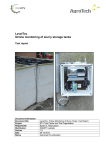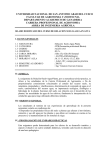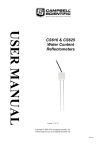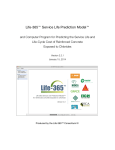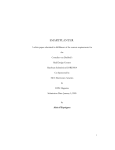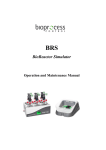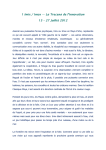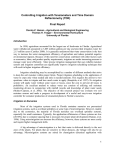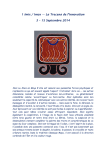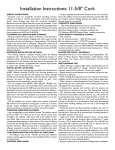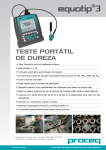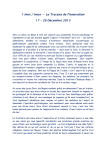Download Measurement of soil moisture using gypsum blocks
Transcript
By og Byg Documentation 004 Measurement of soil moisture using gypsum blocks Measurement of soil moisture using gypsum blocks Birgitte Friis Dela By og Byg Documentation 004 Danish Building and Urban Research 2001 Title Subtitle Serial title Edition Year Author Language Pages References Danish summary Key words Measurement of soil moisture using gypsum blocks Page 28 Building materials, moisture, soil, calibration, gypsum blocks ISBN ISSN 87-563-1075-7 1600-8022 Price DKK 62,50 incl. 25 per cent VAT Publisher By og Byg Danish Building and Urban Research P.O. Box 119, DK-2970 Hørsholm E-mail [email protected] www.by-og-byg.dk By og Byg Documentation 004 1 edition 2001 Birgitte Friis Dela English 28 Page 19 Extracts may be reproduced but only with reference to source: By og Byg Documentation 004: Measurement of soil moisture using gypsum blocks. (2001) Content Foreword......................................................................................................... 4 Summary......................................................................................................... 5 1 Introduction................................................................................................. 6 Measuring soil moisture ............................................................................. 6 2 Materials..................................................................................................... 8 3 Calibration procedure for gypsum blocks................................................. 10 4 Determination of the retention curve for Kaolin........................................ 11 5 Results from calibration of gypsum blocks............................................... 13 6 Discussion ................................................................................................ 15 7 Conclusions.............................................................................................. 17 8 Acknowledgement.................................................................................... 18 9 References ............................................................................................... 19 Appendix A Test Method .............................................................................. 20 Calibration of gypsum blocks for soil moisture measurements................ 20 1 Scope................................................................................................ 20 2 Field of application............................................................................ 20 3 References ....................................................................................... 20 4 Definitions ......................................................................................... 20 5 Sampling........................................................................................... 20 6 Test method...................................................................................... 20 Appendix B.................................................................................................... 25 Sammenfatning............................................................................................. 28 3 Foreword Moisture conditions in the soil surrounding a building are of great importance to the moisture conditions inside the building, and some cases of moisture problems in buildings may be due to high moisture content in the surrounding soil. In order to detect the source of water in the building, measurements of soil moisture are needed. In soil science, gypsum blocks have been used to determine soil moisture content for the past 50 years, and several types of commercial gypsum blocks are available on the market. The gypsum blocks are provided with a generalized calibration curve. There is no individual calibration curve for the gypsum blocks and there is no information on temperature dependency. This report describes a method for calibrating gypsum blocks for soil moisture measurements. By og Byg, Danish Building and Urban Research Building Technology and Productivity Division January 2001 Jørgen Nielsen Head of Division 4 Summary This report describes the results of Nordtest project 1424-98 with the purpose of developing a calibration procedure for determination of soil moisture by means of gypsum blocks. The calibration procedure has been tested for repeatability and for temperature dependency. The method suggested for calibration of gypsum blocks is based on artificial soil made by mixing neat kaolin and water. The method requires knowledge of the retention curve for kaolin. 5 1 Introduction Moisture conditions in the soil surrounding a building are of great importance to the moisture conditions inside the building and some cases of moisture problems in buildings may be due to high moisture content in the surrounding soil. In order to detect the source of water in the building, measurements of soil moisture are necessary. Measuring soil moisture Soil moisture can be measured by use of gypsum blocks, basically, by using the method for wooden dowels described in NT Build 420 (1993). Gypsum is an inorganic material and therefore gypsum blocks are not sensitive to rot contrary to wooden dowels. This fact is crucial when dealing with soil measurements since the moisture content of soil can be very high. However, gypsum will disintegrate if exposed to frost. Gypsum blocks have been used in soil science for the past 50 years (Bouyoucos, 1965), and several types of commercial gypsum blocks are available on the market. Gypsum blocks are delivered with a standard curve showing the relation between measured resistance and soil moisture tension (suction pressure). There is no calibration curve for the actual gypsum block and there is no information on temperature dependency. In Figure 1 an example of such a standard “calibration” curve is shown. The curve shown in Figure 1 is also available as data listed in a table but there is no information about scatter in resistance between different gypsum blocks. Hence, interpretations of resistance measurements are rather uncertain. To obtain better information about the relation between measured resistance and suction pressure it is necessary to calibrate each gypsum block prior to testing. It is the scope of this project to devise a suitable method for calibrating gypsum blocks for soil moisture measurements. 6 Figure 1. Example of standard curve provided by the manufacturer of Delmhorst gypsum blocks. The curve shows the relation between measured resistance and suction pressure (moisture tension). 7 2 Materials The gypsum blocks used in the experiments presented in this report are made by Delmhorst Instrument Co. The blocks are cylindrical having a diameter of 25 mm and a length of 35 mm. Two concentric rings of wire mesh are embedded in the gypsum block and make up the electrodes. In this way, flow of electric current is confined to the interior of the block eliminating the effects of soil conductivity. The resistance between the electrodes varies with the moisture content of the gypsum block, which in turn varies with the suction pressure in the surrounding soil. Thus measuring the AC resistance of the gypsum blocks provides information of the suction pressure in the surrounding soil. The gypsum acts as a buffer against the effect that salts might have on the electrical conductivity. In Figure 2 a picture of a Delmhorst gypsum block is shown together with an illustration of the placement of electrodes. Figure 2. On the left is shown a Delmhorst gypsum block. The drawing on the right hand side illustrates the shape and the placement of the embedded electrodes. Calibrations of the gypsum blocks are carried out using a Campbell Scientific CR10 data-logger that measures the AC resistance of the gypsum block every 10 minutes. A multiplexer is preferably used when connecting two or more gypsum blocks to the data-logger. This eliminates interference between the channels. The measuring range of the gypsum blocks is from suction pressure of 0.1 bar to 15 bar. This range corresponds to very high relative humidity (about 99 % to 99.99 %). Artificial soil samples have been used in the calibrations in order to obtain well-defined suction pressure. Kaolin is a very fine-grained powder with a behavior close to that of clay. The retention curve describes the relation between water content and suction pressure of a porous material. In Figure 3 typical retention curves are shown for different types of soil. 8 0.6 Water content [vol/vol] 0.5 Clay loam 0.4 Clay Fine sand 0.3 Coarse sand 0.2 0.1 0 1 0.1 Suction [bar] 0.01 Figure 3. Typical retention curves for sand and clay (van Es and Ogden, 1997). Here, the water content is the volumetric water content. The retention curve for clay covers a relatively wide range of water contents ranging from 0.1 to 15 bar. Considering the same behavior for kaolin, would facilitate control of suction pressure by water content of the kaolin mixes. 9 3 Calibration procedure for gypsum blocks Water-kaolin mixes of water contents between 20 % and 60 % of the dry weight of kaolin were prepared by use of an electrical mixer. Kaolin mixes having a water content below approximately 35 % were in a grainy phase whereas kaolin mixes containing more water were in a plastic phase. Mixes having a water content around 35 % were very “heavy“, and a powerful mixer was needed. The mixes were put in containers (diameter: 60 mm, height: 45 mm) and sealed with a screw cap. At least two containers (“A” and “B”) were needed for every mix. To reduce drying the containers were stored in a closed box with a high relative humidity (RH>95 %). Prior to utilization, the gypsum blocks were soaked and dried at room conditions. This wet-dry cycle is recommended by the manufacturer in order to improve uniformity of the blocks. Also, the gypsum blocks were dried at room conditions (RH=50 %, T=24 °C) before every calibration cycle. In this way adsorption was ensured in every cycle and misleading results caused by hysteresis were prevented. A gypsum block was placed in the center of a container “A” filled with kaolin mix. The lead wire was led through a hole in the screw cap. The hole was sealed with wax sealant. AC resistance was measured every 10 minutes until a constant level was observed (asymptotic behavior). A constant level would indicate moisture equilibrium between gypsum block and kaolin mix. Then the gypsum block was moved from container “A” to container “B”. Moving the screw cap along with the gypsum block from container “A” to container “B” facilitated the sealing of the containers. AC resistance was measured every 10 minutes until a new equilibrium was obtained (within 1-2 days). The gypsum block was removed from container “B” and left to dry at room conditions. A kaolin sample was taken from each container immediately after removal of the gypsum blocks. The sample was to be used for determining the water content of the mix and should preferably be taken from areas that had been in direct contact with the gypsum block. The water content was determined from the mass of the “fresh” sample mwet and the mass mdry of the sample after it was oven-dried at 105 °C. A high-resolution balance was needed for small samples. In the present tests a balance having a resolution of 0.001 g was used and the samples had an approximate weight of 3 g prior to drying. The retention curve for kaolin was needed to be able to determine the suction pressure of the kaolin samples by their water content. Unfortunately, the retention curve for kaolin was difficult to find in the literature. Therefore, in this project the retention curve has been determined experimentally. In Section 4 a short description is given of the procedure for determining the retention curve by using a thermocouple psychrometer. 10 4 Determination of the retention curve for kaolin The retention curve for kaolin was determined by using a Decagon Devices SC-10A Thermocouple Psychrometer. The psychrometer is especially suited for measurements of suction pressure in soil. It was assumed that the thermocouple psychrometer could provide the most precise results on suction pressure in the range from 0.1 bar to 15 bar. Alternative methods could have been among others: the pressure plate/pressure membrane method, the Whatmann No. 42 filterpaper method (determining the moisture uptake from a soil sample), and the tensiometer method. In Figure 4 an illustration is shown of the measuring range of different types of measuring equipment for determination of suction pressure. Pressure plate/pressure membrane Whatman No. 42 Tensiometer Decagon Thermocouple Psychrometer Water content [g/g] Gypsum blocks Retention curve for kaolin 1000 100 10 1 Suction [bar] 0.1 0.01 Figure 4. Illustration of measuring range for different types of measuring equipment for determination of suction pressure. According to the operator’s manual, the Decagon SC-10A psychrometer should be able to measure suction pressure down to 0 bar (0 µV). However, the resolution of the nanovoltmeter measuring the voltage over the thermocouple is approximately 100 nV leading to a resolution of 0.2 bar. The thermocouple psychrometer had been calibrated on NaCl-solutions prior to testing on kaolin samples. Well-known levels of suction pressure were obtained using NaCl-solutions at prescribed concentrations of 0.05 molal, 0.2 molal, and 0.3 molal. The psychrometer constant is a calibration factor determined from these calibrations. The psychrometer constant varies with atmospheric pressure and is relatively insensitive to temperature. In Figure 5 the psychrometer factors from 3 series of calibrations are shown. 11 Psychrometer factor [kPa/°C] 0.1 0.08 0.06 0.04 0.02 0 0.05 0.2 0.3 0.05 0.2 0.3 NaCl-concentration [molality] 0.05 0.2 0.3 Figure 5. Results from calibration of SC-10A Thermocouple Psychrometer. The calibration is based on NaCl solutions. The straight line indicates the average psychrometer factor used in the tests. In Figure 5 a straight line indicates the average psychrometer constant (0.0763 kPa/°C). Measurements carried out with the thermocouple psychrometer were carried out as specified in the user’s manual. Small sample-cups were filled with kaolin samples and placed in the set-up for equilibrium. After measuring, the cup and samples were weighed on a highresolution balance (0.001 g) and the samples were oven-dried at 105 °C and re-weighed. Also, the empty cups were weighed for determination of water content of the sample. The retention curve was obtained by plotting the measured suction pressure against the measured water content. In Figure 6 the results from the measurements are shown and a curve fit based on the results is given. The curve fit for the retention curve is presented by the following equation: æ æ 0.202 bar ö 0.756 ö kg ÷ + 0.706 kg ÷÷ u = −0.500 kg ⋅ expç − çç kg ç è ÷ p ø è ø where u is the gravimetric water content and p the suction in bar. 0.6 Water content [g/g] 0.5 0.4 0.3 0.2 10 1 Suction [bar] 0.1 0.01 Figure 6. Results from measurements using a SC-10A Thermocouple Psychrometer to determine the relation between water content and suction pressure in kaolin. 12 5 Results from calibration of gypsum blocks A total of 6 gypsum blocks have been calibrated in kaolin mixes. Every gypsum block has been calibrated at 4 different moisture contents. The results are shown in Figure 7 by the suction pressure as a function of the measured AC-resistance. The suction pressure at room temperature was determined by the measured water content and by use of the retention curve shown in Figure 6. 100000 Gypsum blocks No.1 No.2 No.3 No.4 No.5 No.6 Standard curve Resistance [Ohm] 10000 1000 100 10 0.1 1 Suction [bar] 10 100 Figure 7. Results from calibration of gypsum blocks. The full line represents the standard curve as obtained by use of the data given in Figure 1. The results from the calibration are shown for each of the 6 gypsum blocks in Appendix B. In these figures, a curve fit is shown as well. The curve fits have the following expression: ln (R (T0 ) ) = A ⋅ ln (s ) + B where R is the resistance, s the suction pressure, and T0 the calibration temperature. The constants A and B are fit parameters. The results from the curve fitting are given in Table 1. Table 1. Results from calibration of 6 gypsum blocks. Gypsum block A B No. 1 1.90 5.88 No. 2 2.17 6.06 No. 3 1.49 6.37 No. 4 1.83 5.80 No. 5 1.69 6.12 No. 6 1.42 5.98 Results from the investigation of temperature dependency on the resistance of the gypsum blocks are shown in Figure 8. The results present the influence of temperature on resistance of 6 gypsum blocks stored in different kaolin mixes. 13 16000 Gypsum block No. 1 No. 2 No. 3 No. 6 No. 5 No. 4 Resistance [Ohm] 12000 R(23°C)=656 Ohm R(23°C)=133 Ohm R(23°C)=109 Ohm R(23°C)=1001 Ohm R(23°C)=3141 Ohm R(23°C)=6153 Ohm 8000 4000 0 0 5 10 15 Temperature [°C] 20 25 Figure 8. Influence of temperature on resistance of gypsum blocks. As indicated by the linear curve fits in Figure 8 the resistance of gypsum blocks may be considered linearly related to the temperature. In Figure 9 a plot of the slope of the curves in Figure 8 is shown against the resistance of the gypsum block measured at 23 °C. -400 dR/dT [Ohm/°C] -300 Y = -0.064 * X -200 -100 0 0 2000 4000 R(T=23 °C) [Ohm] 6000 8000 Figure 9. Plot showing the slope of resistance relative to temperature against the resistance at 23 °C. In Figure 9 a straight line through origin represents a proposal for describing the influence of temperature on the resistance of gypsum blocks. Using this proposal, the following relation between resistance and temperature can be found: R (T ) = (1 + 0.064 °1C ⋅ (T0 − T )) ⋅ R (T0 ) Using this expression, it is possible to estimate the resistance at T0 = 23 °C when the resistance at a given temperature is known. 14 6 Discussion The results obtained in the calibration procedure are all based on an experimentally determined retention curve on kaolin. Therefore, the uncertainty of the calibrations is correlated to the uncertainty of the retention curve. The retention curve for kaolin presented in Figure 6 has the same shape as the retention curve for clay presented in Figure 3. However, it has not been possible to check the accuracy of the measurements made with the thermocouple psychrometer. In order to compare the results with other principles of measurements, the Whatman No. 42 filter paper method has been applied. In Figure 10 the results from the filter paper test are shown together with the results using the thermocouple psychrometer. Also, some results obtained as a by-product of measurements using the pressure plate apparatus (Strømdahl, 1997) are shown in this figure. 0.6 Water content [g/g] 0.5 0.4 0.3 Thermocouple psychrometer Pressure plate apparatus Whatmann No. 42 filter paper 0.2 10 1 Suction [bar] 0.1 0.01 Figure 10. Retention curves for kaolin according to different methods of measurements. Measurements of suction pressure in the high moisture range are prone to large uncertainties. This is indicated in Figure 10 by the large differences in the results from different test methods. The thermocouple psychrometer is considered the most accurate method for this type of measurement. Nevertheless, the results from the calibration of the gypsum blocks are related to the uncertainty of the retention curve. Therefore, it is preferable to make an inter-laboratory test to ensure that the retention curve for kaolin is correct. The results from the calibration are shown in Figure 7, assuming that the retention curve for kaolin obtained by use of the thermocouple psychrometer is correct. In the same figure, the standard curve proposed by the manufacturer of the gypsum blocks is shown. Unfortunately there is a significant difference between the experimental results and the standard curve. The difference is up to a factor of 5, and thus, the results from the calibration should be seen in the light of the lack of knowledge regarding the correct retention curve. In any case, however, the calibration will reveal if a gypsum block is malfunctioning. Two such defective gypsum blocks were found in this study. The influence of temperature on the measured resistance of the gypsum blocks is presented in Figure 8. The relations should be seen as rules of thumb for the interpretation of results obtained at temperatures other than 23 °C. Soil measurements on site will most likely be made at temperatures at 5- 15 10 °C. Therefore, calibrations carried out at temperatures in this range are to be preferred. However, it is important to note that the retention curve in Figure 6 is based on measurements made at 23 °C. If the calibration of gypsum blocks has been carried out at temperature T0, field measurements can then be given the following interpretation using the curve fit in Figure 9: R (T0 ) = R (T ) 1 + 0.064 °1C ⋅ (T0 − T ) where R is the resistance and T the temperature. The resistance at the temperature T0 = 23 °C can then be used directly in the expression from the calibration: é ln (R(T0 ) ) − B ù s = exp ê ú A ë û where s is the suction pressure and R the resistance at calibration temperature T0. The factors A and B are constants determined in the calibration. 16 7 Conclusions A calibration procedure for gypsum blocks for soil moisture measurement has been proposed. The calibration method is based on the use of kaolin as artificial soil. Knowledge of the retention curve for kaolin is required. An experimental investigation of the relation between moisture content and suction pressure for kaolin has been carried out. Based on the results from this investigation a retention curve has been suggested. An investigation has been carried out concerning the influence of temperature on the resistance of the gypsum blocks. The results have led to a proposal for a rule of thumb for the relation between resistance measured at temperatures other than 23 °C. The calibration procedure has been performed on 6 gypsum blocks at 4 different moisture levels. The results from the calibration show only small differences between the gypsum blocks. However, the results from the calibration are differs significantly from the standard curve given by the manufacturer of the gypsum blocks. This may be due to the fact that the retention curve is prone to large uncertainties. Due to the inadequate information available on calibrations and temperature dependency of gypsum blocks today, it is recommended that the calibration method is published as a “Nordtest Method”. Furthermore, it is suggested that an inter-laboratory test is carried out in order to improve the accuracy of the retention curve. 17 8 Acknowledgement The SC-10A Thermocouple Psychrometer for determination of the retention curve of kaolin was kindly lent by Dr. Christian Jensen at The Royal Veterinary and Agricultural University. His help and kindness are highly appreciated. 18 9 References Bouyoucos, G. J. (1965), Plaster of paris block electrical measuring unit for making a continuous measurement of soil moisture under field conditions. In A. Wexler (Ed.), Humidity and moisture: Measurement and control in science and industry (Vol. 4, pp. 105-111). New York: Reinhold. van Es, H., and Ogden, C. (1997), Water in soil. Ithaca, NY: Cornell University. Available 23trd August 1999 at: http://wwwscas.cit.cornell.edu/hmv1/watrsoil/charcurv.htm. Nordtest. (1993). Building materials, wood: Moisture content with electrical resistance in built-in wooden probes (NT-Build 420). Espoo, Finland. Strømdahl, K. (1997). Fugt i byggematerialer med fokus på vandbinding i det overhygroskopiske område (in Danish; Moisture in building materials - with focus on water retention in the superhygroscopic region, MSc thesis). Lyngby: Danmarks Tekniske Universitet, Institut for Bærende Konstruktioner og Materialer. 19 Appendix A Test Method Calibration of gypsum blocks for soil moisture measurements Key words: Building materials, moisture, soil, calibration, gypsum block, electrical resistance, suction 1 Scope This test method covers the determination of calibration curves of gypsum blocks used to determine the suction pressure in soil. 2 Field of application Gypsum blocks can be used to determine the suction pressure in soil indirectly. Gypsum blocks have been used in soil science for the past 50 years, and several types of commercial gypsum blocks are available on the market. The gypsum blocks are delivered with a standard curve showing the relation between measured resistance and suction pressure. There is no calibration curve for the actual gypsum block and there is no information on temperature dependency. This calibration procedure serves to calibrate gypsum blocks prior to application. 3 References 4 Definitions Moisture content The gravimetric moisture content u (kg/kg) is the ratio between the mass of evaporable water and the oven dry mass of material. Relative humidity Relative humidity, RH, of air is the ratio between the actual partial watervapor pressure and the saturation water vapor pressure at the temperature of the air. Suction pressure The suction pressure s (bar) is the pressure difference between the porewater pressure and the ambient total pressure. Retention curve or soil moisture retention curve Relationship between soil moisture content and suction pressure. 5 Sampling Generally, the number of samples decides the accuracy of the calibration. At least 3 samples are needed. The sample size should be at least 2×150 ml of kaolin mix. 6 Test method 20 6.1 Principle Gypsum blocks are brought in suction pressure equilibrium with kaolin at given moisture contents. AC resistance of a gypsum block is determined at time of equilibrium. The water content of the surrounding kaolin is determined at time of equilibrium. The retention curve for kaolin is used to determine the kaolin suction pressure at equilibrium from the water content. The measured AC resistance at equilibrium versus the kaolin suction pressure constitutes the calibration curve for the gypsum block. 6.2 Apparatus Electric mixer (i.g. mixer for cement paste and mortar) for mixing kaolin and water. Ventilated oven capable of maintaining a desired temperature of 105 °C with an accuracy of ±2 °C. Containers provided with a cap. Gypsum block for measurement of suction pressure. High-resolution AC resistance measurement apparatus. Kaolin powder (i.g. Fluka Chemie, No. 60609 distributed by Sigma-Aldrich Chemie). Balance with a resolution of at least 0.01 g (preferably 0.001 g). Thermometer with a resolution of 0.5 °C. Thin-walled pipe with an outer diameter equal to the diameter of a gypsum block. The length should be 10-15 cm. 6.3 Preparation of test specimens The gypsum blocks are soaked in water for at least 1 hour and then dried at room condition. This procedure is carried out twice in order to improve the performance of the gypsum blocks. 6.4 Procedure 6.4.1 The test shall be carried out at a constant temperature of 23°±1 °C. 6.4.2 Kaolin and water are mixed thoroughly. The content of water should range from 20 % to 60 % by mass of the kaolin. 6.4.3 Sets of two containers (“A” and “B”) with the same kaolin mixes are prepared for gypsum blocks. A hole is made at the centre of the kaolin in container “A” using a piece of pipe. The pipe has an outer diameter equal to the diameter of the gypsum block. 6.4.4 A dry gypsum block is placed in the hole in container “A” and the wire is led through an opening in the cap of the container. The container is sealed and stored at high relative humidity (RH>95 %). Measurements of the AC resistance are carried out until equilibrium is observed. Equilibrium should be reached within 2-3 days. 6.4.5 When equilibrium is obtained, the gypsum block is removed from container “A” and placed in the corresponding container “B”. The kaolin mix in container “B” is the same as the kaolin mix in container “A”. The procedure in steps 6.4.3 and 6.4.4 is repeated for container “B” except that the gypsum block is not dry but in moisture equilibrium with the kaolin in container “A”. Note: The reason for placing the gypsum blocks in two containers with identical kaolin mixes is to reduce an error that might occur if there is a (significant) suction gradient from the surrounding kaolin mix to the center of the gypsum block. By equilibrating the moisture content in the gypsum block before 21 placing it in container “B”, the suction gradient will be reduced. 6.4.6 When equilibrium is obtained in container “B”, the AC resistance is registered. The gypsum block is removed and a sample of kaolin is taken from the area next to the hole for the gypsum block. The sample should weigh more than 3 g when the balance used for weighing has a resolution of at least 0.01 g. The mass mwet of the sample is determined shortly after removal from the container (less than a minute). 6.4.7 The sample is oven-dried at 105 °C until the weight loss is less than 0.01 g over a period of 6 hours. The mass mdry of the sample is determined after it has cooled to room temperature in a (dry) container with silica gel. 6.4.8 The gypsum block is dried at room condition until the AC resistance is above 100 kΩ. 6.4.9 Steps 6.4.2 to 6.4.6 is repeated for at least 3 kaolin mixes having water contents ranging from 20 % to 60 %. 6.5 Expression of results 6.5.1 The moisture content by mass is determined by u= mwet − mdry mdry where mwet is the mass of the sample just after removal from the container and mdry is the mass of the sample after it has been dried in the oven. 6.5.2 The suction pressure s is determined by s= 0.202 bar é æ 0.500 kg öù kg ÷ ú êlnç ê çç 0.706 kg − u ÷÷ú kg øûú ëê è 1.323 where u is the moisture content by mass. This expression is valid for the proposed retention curve for kaolin of the type Fluka Chemie, No. 60609 distributed by Sigma-Aldrich Chemie. If other types of kaolin (or soil or material) are used, the retention curve has to be determined for that specific material. The retention curve can be determined by using for example a thermocouple psychrometer. 6.5.3 Plotting the suction pressure s of the kaolin against the resistance R of the gypsum block in a double log scale a curve fit having the following expression can be found: ln[R (T0 )] = A ⋅ ln[s ] + B where A and B are fit constants. The calibration temperature T0 is equal to 23 °C in this case. 6.5.4 22 For resistance measurements made at temperatures deviating from the calibration temperature, the following expression may be applied: R (To ) = R (T ) 1 + 0,064 °1C (T0 − T ) where T0 is the calibration temperature (23 °C) and T is the t emperature at time of measurement. This expression is only valid for T0 = 23 °C. If the calibration is carried out at another temperature, the corresponding relation must be found. 6.5.5 Having determined the calibration factors A and B the gypsum block can be used to obtain the suction pressure in soil. The suction pressure is then determined from the following expression: é ln s = exp êê ë (R(T0 ) ) − B ùú A ú û where R(T0) is the resistance of the gypsum block according to Section 6.5.4. 6.6 Accuracy The accuracy of the calibration method depends on the handling of the samples. Samples for determining the water content of kaolin mixes should be handled in such a way that drying of the wet samples is reduced until mwet is determined. Required minimum size of samples is related to the resolution of the balance. 6.7 Test report The test report shall include the following information: a) b) c) d) e) Name and address of the testing laboratory Identification number of the test report Name and address of the organisation or the person who ordered the test Purpose of the test Choice of points of measurements and other circumstances (date and person responsible for sampling) f) Method of sampling and specimen preparation g) Address and detailed description of the place where the samples have been taken out i) Date when the measurement was ordered j) Date of measurement k) Test method l) Conditioning of the sample type and probe, ambient conditions during measurement (temperature, RH etc.) m) Identification of the equipment used for measurement (product, model and laboratory equipment identification number) n) Any deviations from method of measurement o) Test results according to clause 6.5 p) Inaccuracy or uncertainty of the measurement q) Date and signature 23 0.8 Water content [g/g] 0.7 0.6 0.5 0.4 0.3 0.2 10 1 Suction [bar] 0.1 0.01 Retention curve for kaolin of the type Fluka Chemie, No. 60609 distributed by Sigma-Aldrich Chemie. Resistance [Ohm] 10000 1000 100 No.6 ln(Y) = 1.422366283 · ln(X) + 5.982964972 10 0.1 1 Example of calibration curve for a gypsum block. 24 Suction [bar] 10 100 Appendix B Resistance [Ohm] 10000 1000 100 No.1 ln(Y) = 1.897110006 · ln(X) + 5.881492414 10 0.1 1 Suction [bar] 10 100 Figure 11. Results from calibration of gypsum block No. 1 shown together with curve fit. 100000 Resistance [Ohm] 10000 1000 100 No.2 ln(Y) = 2.169254397 · ln(X) + 6.057218363 10 0.1 1 Suction [bar] 10 100 Figure 12. Results from calibration of gypsum block No. 2 shown together with curve fit. 25 Resistance [Ohm] 10000 1000 100 No.3 ln(Y) = 1.490756234 · ln(X) + 6.368459876 10 0.1 1 Suction [bar] 10 100 Figure 13. Results from calibration of gypsum block No. 3 shown together with curve fit. Resistance [Ohm] 10000 1000 100 No.4 ln(Y) = 1.825053063 · ln(X) + 5.798195426 10 0.1 1 Suction [bar] 10 Figure 14. Results from calibration of gypsum block No. 4 shown together with curve fit. 26 100 Resistance [Ohm] 10000 1000 100 No.5 ln(Y) = 1.687807465 · ln(X) + 6.115224892 10 0.1 1 Suction [bar] 10 100 Figure 15. Results from calibration of gypsum block No. 5 shown together with curve fit. Resistance [Ohm] 10000 1000 100 No.6 ln(Y) = 1.422366283 · ln(X) + 5.982964972 10 0.1 1 Suction [bar] 10 100 Figure 16. Results from calibration of gypsum block No. 6 shown together with curve fit. 27 Sammenfatning By og Byg Dokumentation 004: Kalibrering af gipsblokke til bestemmelse af jords fugtighed Denne rapport beskriver resultater fra Nordtest projekt 1424-98, som havde til formål at udvikle en kalibreringsprocedure for gipsblokke, der anvendes til bestemmelse af fugtindhold i jord. Kalibreringsproceduren er blevet undersøgt for repetérbarhed og for temperaturafhængighed. Den kalibreringsmetode, der foreslås for gipsblokke, er baseret på anvendelse af en kunstig jordprøve, der består af en blanding af ren kaolin og vand. Metoden forudsætter kendskab til retentionskurven for den anvendte kaolin. 28 For the past 50 years, gypsum blocks have been used to determine soil moisture content. This report describes a method for calibrating gypsum blocks for soil moisture measurements. Moisture conditions inside a building are strongly influenced by the moisture conditions in the soil surrounding the building. Consequently, measuring the moisture of the surrounding soil is of great importance for detecting the source of moisture in a building. Up till now, information has been needed to carry out individual calibrations for the different types of gypsum blocks available on the market and to account for individual temperature dependencies. But with this report, the information is now available. 1 edition, 2001 ISBN 87-563-1075-7 ISSN 1600-8022

































